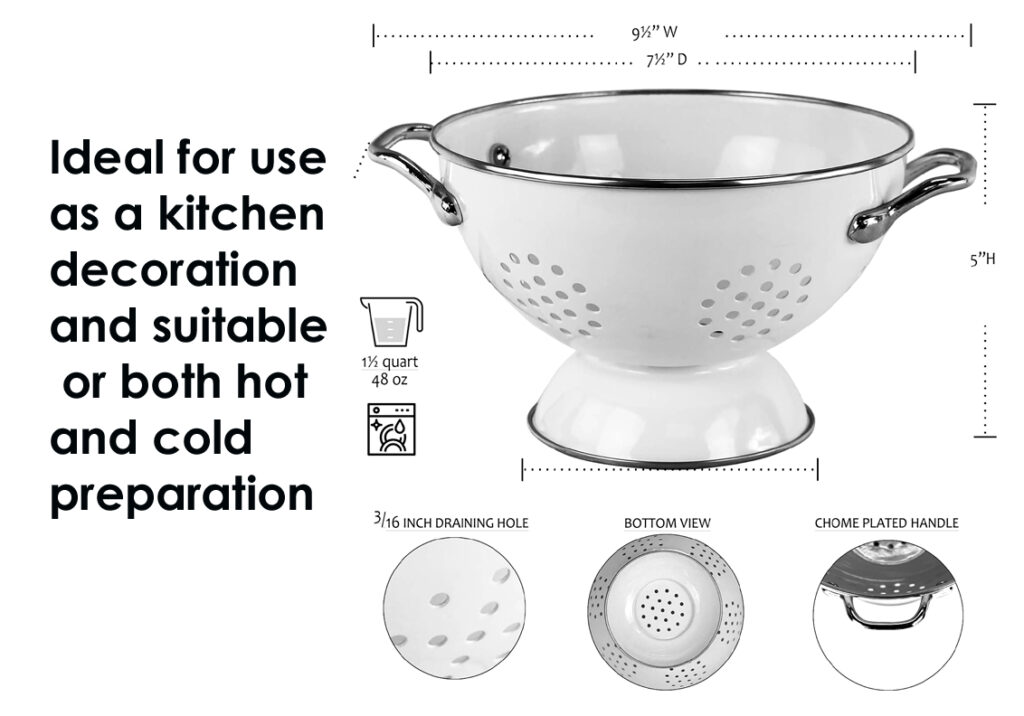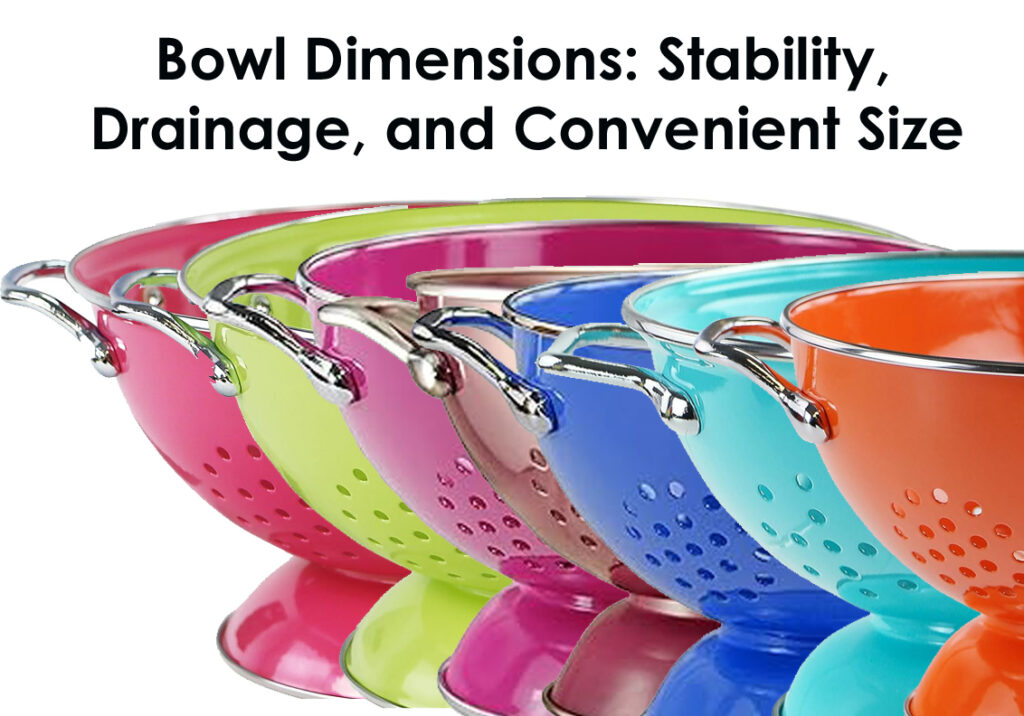I. Introduction
Curious about kitchen essentials? ‘What Is a Colander?’ Let’s dive into its types, uses, and more, unveiling culinary secrets together. A colander is essentially the culinary maestro of liquid separation, not just any old kitchen tool. Imagine a bowl that has been thoughtfully punctured to turn ordinary chores into delicious meals. It’s essentially the unseen hero that makes sure your veggies stay crisp and colorful and your pasta gets the ideal al dente texture. Peeling back the layers and investigating its historical origins and contemporary transformation reveals a kitchen essential of great significance. One drain at a time, this seemingly basic instrument is the unsung hero that transforms the ordinary into the remarkable and enriches our cooking experience.
II. Historical Evolution
Let’s take a trip down memory lane and explore the history of straining and its intriguing early uses. Explore the evolution of this indispensable cooking item from ancient kitchens to the Renaissance. What began as a simple strainer has evolved into a wide range of styles, with every historical period leaving its own mark. Come explore the fascinating background and development of the colander’s design with me.


III. Types of Colanders
In a world of strain, diversity reigns supreme. Traditionalists swear by the sturdiness of metal, while plastic variants offer a lightweight twist. Venture further, and you’ll encounter the sleek, modern allure of silicon colande, pushing the boundaries of innovation. From timeless classics to cutting-edge designs, the colander landscape is as varied as the dishes it helps create. Let’s explore these kitchen companions, each with its own unique charm and role in making our culinary adventures seamless and enjoyable.
IV. Functions and Utility
Unleashing the colander’s magic lies in its exceptional straining prowess, turning kitchen tasks into a breeze. Beyond mere drainage, discover its versatility—ideal for washing, sifting, and even serving. Let’s debunk common misconceptions, unveiling the true extent of this culinary ally’s capabilities, making it a must-have for both seasoned chefs and kitchen novices alike.
V. Materials Used in Colander Manufacturing
Explore the world of expertly crafted collanders. Stainless steel is durable and classic. Discover the range of options provided by plastic’s versatility. Observe the contemporary charm of silicon, a substance that transforms kitchenware. Every choice, a demonstration of creativity and flair, guarantees that your colander blends in perfectly with your taste buds and way of life.

VI. Key Features to Consider When Buying
Size matters, especially in the world of stretching. Delve into the nuances of choosing the right size and capacity for your culinary endeavors. Explore handle designs, ensuring comfort and ease in every pour. Uncover the secrets of durability and maintenance, because a reliable colander is not just a tool—it’s a kitchen companion built to last.
VII. Comparing Popular Brands
Before we dive in, let’s dispel the mystery around “What Is a Colander?”—the unsung hero of the kitchen. After that, we examine the market in depth, reviewing a well-known brand in detail, and then evaluating a competitor in depth. Lastly, we highlight the unique qualities that distinguish a brand and make it stand out in the wide world of colanders.
VIII. User Experiences
Discover the knowledge of individuals who have used the straining. Examine user reviews and ratings to learn about personal experiences that will influence your decision. Listen to the opinions of gastronomic experts in testimonies, which provide valuable information that turns your choice of Straining into a knowledgeable and professional choice. Both expert chefs and ardent home cooks have molded this culinary adventure.
IX. Colanders in Different Culinary Cultures
Embark on a global culinary tour with Straining as your guide. In Italy, witness its integral role in crafting perfect pasta dishes. Traverse to Asia, where it seamlessly blends into diverse culinary traditions. Explore American and European kitchens, discovering unique applications that make the Straining a universal symbol of culinary versatility. It’s a journey where cultures converge, united by the indispensable colander.
X. Sustainability and Eco-Friendly Options
Consider the environment when making decisions about your kitchen. Discover colanders made of eco-friendly materials to make sure your kitchenware is in line with your environmental principles. Examine how the production of Straining affects the environment and highlight effective, sustainable approaches. It’s important to make a decision that is in harmony with the environment rather than merely straining.

XI. Maintenance and Cleaning Tips
- Learn how to take care of your strainer to prolong its life as a cooking friend. Discover the right cleaning techniques to guarantee a spotless tool for each use. Discover how to make your colander a long-lasting kitchen ally by giving it regular care. It’s not only about keeping your colander clean; it’s also about maintaining its longevity and usefulness, which make it a timeless kitchen staple.
XII. Colander Hacks and Alternative Uses
- Explore the creative side of the colander by going beyond the norm. It’s an open canvas for creative crafts and inventive culinary applications, from exciting do-it-yourself projects to unusual kitchen uses. Add some creativity to your cooking routine with these creative stretching projects.
XIII. Colanders in Pop Culture
- Take a journey through pop culture with Colander. Discover the cameos it has made in TV series and films. Examine the symbolic motifs found in literature and art to highlight the unanticipated cultural influence of this necessary kitchen item.
XIV. Common Myths and Misconceptions
- Let’s debunk some fallacies about colanders. Sort fact from fiction as we dispel myths and explain frequent misunderstandings, enabling you to make wise decisions about your gastronomic adventure.


XV. Future Trends in Colander Design
- Take a trip into the colander of the future. Examine how technological advancements are altering this kitchen need. Expect updates to features and materials that should improve your culinary experience. It’s about the fascinating transformation that awaits in the world of Colander, not simply about what’s happening right now.
Pros and Cons
| Pros | Cons |
|---|---|
| 1. 1 1/2-Quart size for versatile use | 1. Hand wash recommended |
| 2. Powder-coated enamel for durability | 2. Not suitable for dishwasher |
| 3. Chrome-plated handles for a stylish look | |
| 4. Stainless steel rims for added strength | |
| 5. Well-placed holes for efficient draining | |
| 6. Suitable for both hot and cold prep | |
| 7. Can serve as a kitchen decoration | |
| 8. Compact size, measuring 9 1/2 x 7 1/2 x 4 1/2-Inch |
Conclusion
- As we come to the end of our investigation, this 1 1/2-quart colander becomes a kitchen necessity. It promises both practicality and flair with its strong powder-coated enamel, chrome-plated handles, and effective drainage design. Its ability to function as both hot and cold prep and kitchen décor broadens its scope. Even though it’s advised, handwashing is an investment worth making because of its long-lasting benefits. So set out on your culinary adventure with confidence and knowledge of how to make a colander that is both useful and beautiful to look at.
Frequently Asked Questions .
What is the ideal material for a colander?
Stainless steel is often considered ideal for its durability and resistance to corrosion. However, it depends on personal preference and specific use cases.
How do I choose the right size for my needs?
Consider your typical food quantities. For smaller tasks, a 1-2-quart coland suffices, while larger quantities may require 3 quarts or more.
Are plastic colanders safe for hot foods?
It depends on the plastic type. High-quality heat-resistant plastics are safe for hot foods, but always check the manufacturer’s guidelines.
Do colanders with handles make a difference?
Yes, handles provide ease in handling and pouring. Ensure they are ergonomically designed for comfortable use.
Can I put my colanders in the dishwasher?
Check the product specifications. While some are dishwasher-safe, others may recommend hand washing to preserve their quality.
What maintenance do stainless steel colanders require?
Stainless steel is durable, but to maintain its shine, hand washing with mild soap is recommended. Avoid abrasive cleaners.

